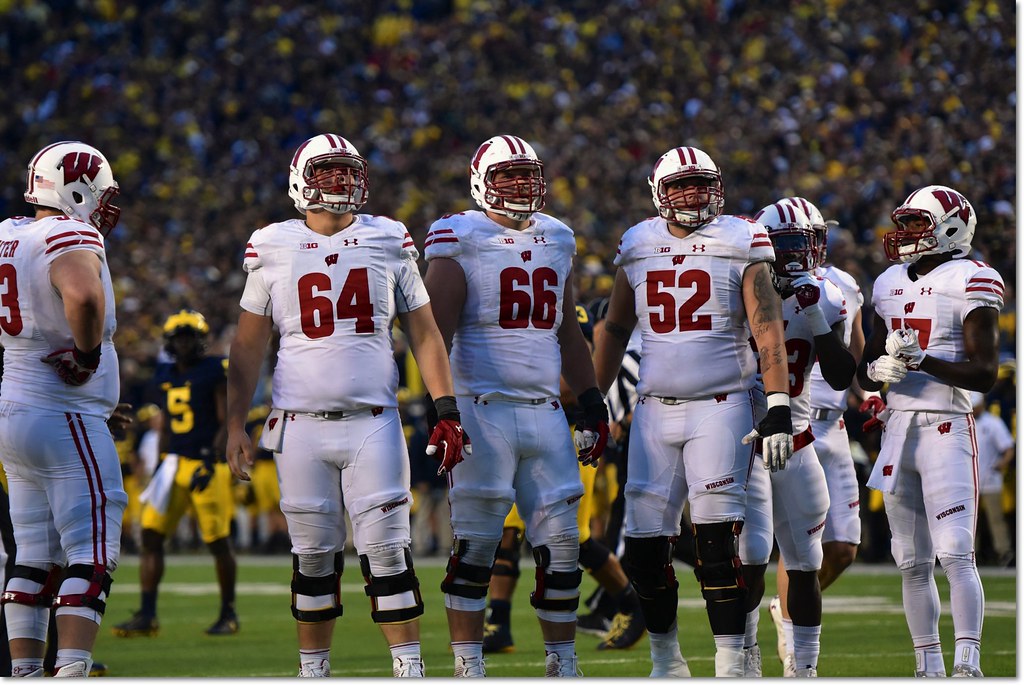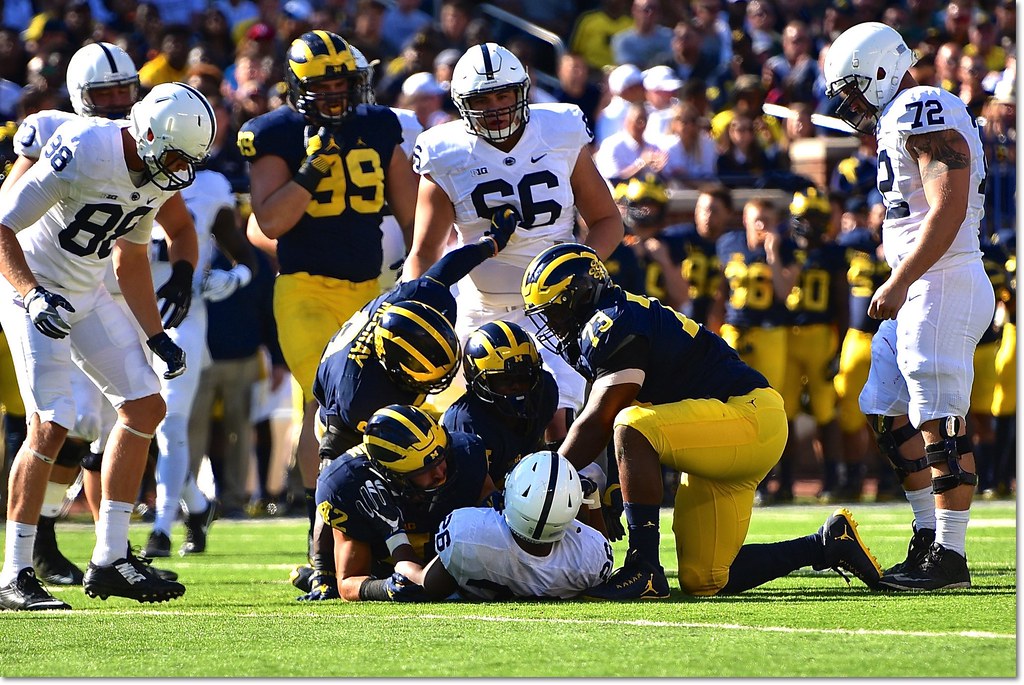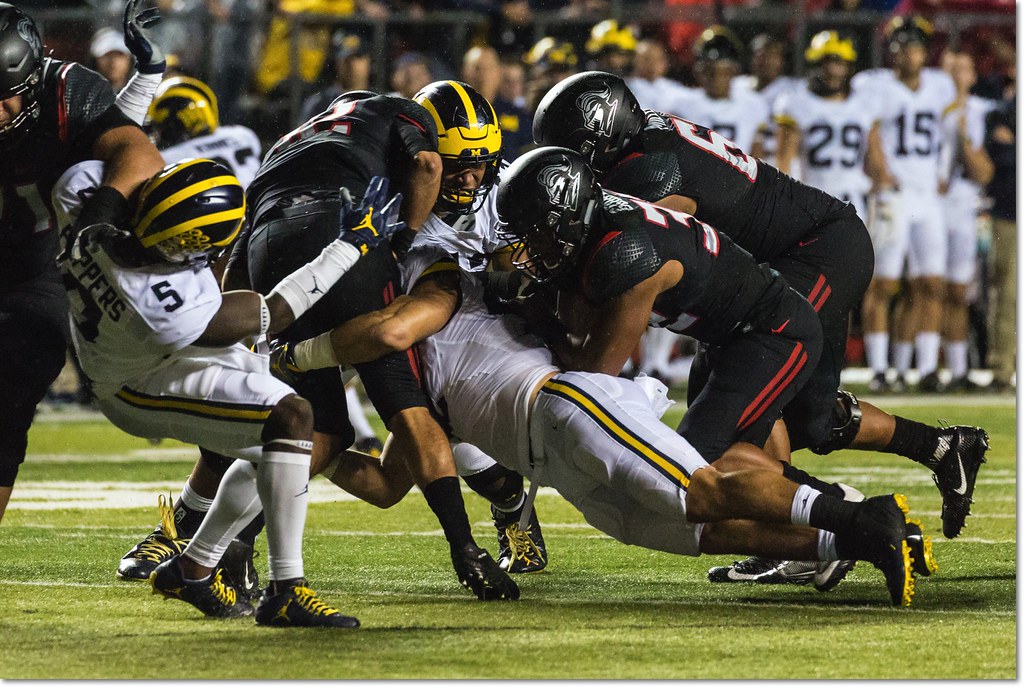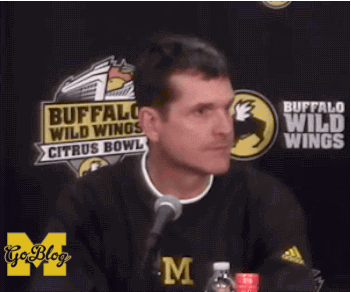The Enemy, Ranked: Offensive Line

Previously: Quarterbacks, Running Backs, Wide Receivers & Tight Ends

Isaiah Prince (#59) had a rough starting debut in 2016. [Bryan Fuller]
The opponent position group previews march on with a look at enemy offensive lines, which somehow may be in a worse state than the enemy quarterbacks. As you'll see from the advanced stats, which I've culled from Football Study Hall, no line Michigan faces this season finished in the top half of the country in both pass- and run-blocking—some were good-to-excellent at one or the other, but none were exceptional at both. That dripping sound you hear is the Michigan defensive line drooling uncontrollably.
You can find explanations for the advanced stats used in this post here.
1. Ohio State
| Returning Starters | Adj. Line Yards (Rank) | Opportunity Rate (Rank) | Power Success Rate (Rank) | Stuff Rate (Rank) | Adjusted Sack Rate (Rank) |
|---|---|---|---|---|---|
| 4 | 134.6 (1) | 48.0% (2) | 84.6% (2) | 13.4% (6) | 94.4 (82) |
Ohio State's worst line of the last few years still excelled at creating holes in the run game, especially behind the All-American interior duo of Pat Elflein and Billy Price. Elflein is the only departed starter; Price will slide over to center to take his place, and he'll be a favorite for the Rimington Award. While the interior may not be quite as strong without Elflein, an added year of experience for guard Michael Jordan (NTMJ), who started 13 games as a true freshman in 2016, and new starter Branden Bowen should keep the run-blocking strong.
The issue is pass protection. Ohio State couldn't keep JT Barrett upright last year, an issue that caught up to them in a major way when they faced Clemson in the playoff semis. Left tackle Jamarco Jones is solid, but right tackle Isaiah Prince was a disaster, and he's still in line to start. Bowen played limited snaps last year and didn't look great in pass pro. If Prince and Jordan don't take big steps forward, Barrett will be under fire on a frequent basis again this year.
[Hit THE JUMP for the rest of the list.]
2. Wisconsin

Beef. [Fuller]
| Returning Starters | Adj. Line Yards (Rank) | Opportunity Rate (Rank) | Power Success Rate (Rank) | Stuff Rate (Rank) | Adjusted Sack Rate (Rank) |
|---|---|---|---|---|---|
| 4 | 103.7 (56) | 36.0% (108) | 74.6% (23) | 19.4% (76) | 94.8 (80) |
Wisconsin's offensive line hasn't been a vintage Wisconsin line for a few years now, and while they have four starters coming back, they lose their best player in first-round left tackle Ryan Ramczyk. Interior linemen Beau Benzschawel and Michael Dieter are all-conference level players; otherwise there's the usual mix of local four-stars (redshirt freshman OT Cole Van Lanen), unheralded talent (walk-on OT Brett Connors), and meat.
As Bill Connelly notes, the Badgers return seven linemen with a combined 91 career starts, and those seven players are 6'6", 321 pounds on average. The sheer amount of returning experience should keep Ramczyk's absense from hurting too much; I'm still skeptical Paul Chryst can get this group back to its past elite form. They can still bull straight ahead in short-yardage situations, as their power success rate indicates, but they didn't do anything else well last year and lost their best player.
3. Florida
| Returning Starters | Adj. Line Yards (Rank) | Opportunity Rate (Rank) | Power Success Rate (Rank) | Stuff Rate (Rank) | Adjusted Sack Rate (Rank) |
|---|---|---|---|---|---|
| 4 | 95.0 (99) | 35.3% (110) | 69.8% (52) | 17.2% (42) | 123.5 (34) |
Yeah, it's getting bad. While they were decent in pass protection, largely because of scheme, the Gators made excellent back Jordan Scarlett work extremely hard for his yards. This isn't exactly how you want a position group framed in a preseason preview:
He still has plenty of time to grow, as does a line that had to battle constant injury/shuffling — eight guys started at least once, seven started at least four times, and only one started all 13 games — and returns seven players with starting experience, only one of whom is a senior. Guard Martez Ivey leads a line that has almost no choice but to improve.
Ivey is an excellent up-and-coming guard and there's plenty of other developing talent in this unit. They should be better than last year; as noted, that isn't a particularly high bar to clear.
4. Penn State

Nutshell. [Fuller]
| Returning Starters | Adj. Line Yards (Rank) | Opportunity Rate (Rank) | Power Success Rate (Rank) | Stuff Rate (Rank) | Adjusted Sack Rate (Rank) |
|---|---|---|---|---|---|
| 4 | 85.8 (120) | 38.2% (84) | 56.5% (118) | 23.9% (119) | 132.1 (25) |
Yes, that Penn State. While Joe Moorhead didn't solve the run-blocking woes in his first year as offensive coordinator, his scheme change and the massive upgrade in pocket presence from Christian Hackenberg to Trace McSorley helped the team improve from 111th to 25th in adjusted sack rate. Ryan Bates and Brendan Mahon stabilized the once-woeful tackle positions; both return this year, as do four others who got starting experience last year.
While Saquon Barkley doesn't need much to work with, he could put up cartoonish numbers if PSU could simply prevent him from needing to break through contact behind the line on seemingly half his carries. The line has a long way to go in that department, but last year's pass protection turnaround is a good precedent.
5. Michigan State

Cole Chewins (#61) is still quite light for a starting OT. [Patrick Barron]
| Returning Starters | Adj. Line Yards (Rank) | Opportunity Rate (Rank) | Power Success Rate (Rank) | Stuff Rate (Rank) | Adjusted Sack Rate (Rank) |
|---|---|---|---|---|---|
| 3 | 111.4 (27) | 41.5% (44) | 62.9% (96) | 19.4% (76) | 107.9 (46) |
I don't know what to do with the Spartans, who managed to scrape into mediocre status last year despite constant shuffling on the line. Bill Connelly isn't sure, either:
The line is an experiment in optimism vs. pessimism. The optimist would point out that two-year starter Brian Allen is back after anchoring last year’s line and becoming the only lineman to survive all 12 games. Four others with starting experience return; that includes guards Tyler Higby and David Beedle, who started a year’s worth of games between them.
The pessimist would point out that the four most experienced guys after Allen are gone. Higby, Beedle, and tackle Cole Chewins have combined for 14 starts. The four departures combined for 62. Line consistency is a massive requirement for a predictable offense; there’s no guarantee it will exist. Still, a Lewerke-Scott backfield is appealing, and I don’t expect further drop-off from the State offense. I don’t expect improvement either.
I'll add to the pessimism: Beedle was a disaster last year, while Chewins is expected to start at left tackle after spending the better part of three years packing on the pounds to reach... 6'8", 284. That is not a man proportioned to slow down Rashan Gary; Chewins is #61 in the above photo, getting shoved by a linebacker into LJ Scott. Brian Allen is a heck of a player, and younger brother Matt is the next in line to be a good Spartan interior lineman, but there's otherwise a ton of uncertainty surrounding this group.
6. Indiana
| Returning Starters | Adj. Line Yards (Rank) | Opportunity Rate (Rank) | Power Success Rate (Rank) | Stuff Rate (Rank) | Adjusted Sack Rate (Rank) |
|---|---|---|---|---|---|
| 3 | 100.0 (80) | 35.4% (109) | 73.2% (35) | 21.5% (104) | 130.0 (26) |
Indiana's run-blocking took a nosedive with All-American interior lineman Dan Feeney banged up for much of the year. While Feeney's absence and some other injuries helped IU get a young group of linemen valuable experience, the run game is going to have a hard time breaking average without him, especially since the RB group is far less talented than recent years.
That said, the pass protection could get even better. Left tackle Coy Cronk posted a brutal PFF grade as a true freshman, which is what happens to true freshmen; he still flashed plenty of talent. Even without Feeney, this group could take a step forward if they're more fortunate regarding injuries.
7. Maryland

Form: not ideal. [Fuller]
| Returning Starters | Adj. Line Yards (Rank) | Opportunity Rate (Rank) | Power Success Rate (Rank) | Stuff Rate (Rank) | Adjusted Sack Rate (Rank) |
|---|---|---|---|---|---|
| 3 | 113.6 (15) | 42.6% (31) | 52.5% (125) | 22.3% (113) | 57.4 (124) |
Offensive coordinator Walt Bell did his damndest to scheme around this offensive line entirely last year. Maryland's running game focused on getting their speedy backs to the edge; they were far less successful when they tried anything between the tackles. Despite a passing game that didn't threaten downfield often, the Terps were awful in pass protection.
So how is this group seventh? For one, it's obviously a bad year for opposing OLs on the schedule. For another, they've got a surprising amount of talent. Right tackle Damian Prince is a former five-star with a potential NFL career at guard; projected starting left tackle Derwin Gray was a top-100 recruit; former four-star Terrance Davis, a one-time Michigan target, started eight games at guard last year as a true freshman.
They lose their steadiest linemen from last year, tackle Michael Dunn and guard Mike Minter, so even tapping into that potential may only keep Maryland treading water, but Bell has proven he can at least make that work in the run game.
8. Minnesota
| Returning Starters | Adj. Line Yards (Rank) | Opportunity Rate (Rank) | Power Success Rate (Rank) | Stuff Rate (Rank) | Adjusted Sack Rate (Rank) |
|---|---|---|---|---|---|
| 3 | 92.7 (104) | 39.9% (66) | 61.4% (105) | 20.3% (92) | 126.7 (31) |
Another team that was awful at run-blocking and solid at keeping the passer upright in large part due to the structure of the offense, Minnesota has to turn around their line play while also undergoing a significant scheme change under PJ Fleck. The coaching change does bring hope for improvement, however, as Fleck brought in former Ohio State offensive line coach Ed Warinner, one of the better position coaches in the country who struggled some when OSU asked him to take on a co-coordinator role.
9. Air Force
| Returning Starters | Adj. Line Yards (Rank) | Opportunity Rate (Rank) | Power Success Rate (Rank) | Stuff Rate (Rank) | Adjusted Sack Rate (Rank) |
|---|---|---|---|---|---|
| 2 | 103.0 (61) | 43.4% (19) | 72.1% (40) | 12.9% (2) | 66.0 (117) |
It's Air Force. They can't protect the passer, they're undersized, and they lose a lot from last year. They're also extremely well-coached, know their scheme inside and out, and will cut-block the heck out of you. The names of the particular players involved practically doesn't matter.
10. Purdue
| Returning Starters | Adj. Line Yards (Rank) | Opportunity Rate (Rank) | Power Success Rate (Rank) | Stuff Rate (Rank) | Adjusted Sack Rate (Rank) |
|---|---|---|---|---|---|
| 2 | 92.2 (106) | 34.9% (113) | 64.3% (85) | 22.8% (116) | 140.8 (23) |
Kirk Barron is a decent center. The Boilermakers return only one other starter from a line that couldn't get any push, though, and that could mean even worse numbers this year, even with offensive mastermind Jeff Brohm taking over for the overmatched Darrell Hazell. Last year's sack rate was inflated by a passing scheme focused on getting the ball out quickly; even with that, QB David Blough threw 21 picks. That number could, remarkably, rise if the Boilermakers can't keep the pocket clean.
11. Rutgers

TFW you can't tell who's supposed to be blocking and who's supposed to have the ball. [Barron]
| Returning Starters | Adj. Line Yards (Rank) | Opportunity Rate (Rank) | Power Success Rate (Rank) | Stuff Rate (Rank) | Adjusted Sack Rate (Rank) |
|---|---|---|---|---|---|
| 3 | 103.0 (61) | 18.3% (83) | 60.0% (111) | 20.9% (95) | 82.0 (100) |
PFF fave-rave Tariq Cole is an NFL prospect at left tackle; notably, he missed last year's Michigan game.
The rest of the line is constituted of more Rutgersy Rutgers players.
12. Cincinnati
| Returning Starters | Adj. Line Yards (Rank) | Opportunity Rate (Rank) | Power Success Rate (Rank) | Stuff Rate (Rank) | Adjusted Sack Rate (Rank) |
|---|---|---|---|---|---|
| 2 | 104.6 (52) | 36.6% (106) | 65.5% (81) | 19.4% (76) | 102.3 (57) |
A crummy line in a crummy league and they lose three starters to boot. If you can't tell by now, I expect Michigan's defense to mercilessly crush Cinci.
Where Would Michigan Rank?
Man, I don't know. On the one hand, a line that held back the offense loses three starters. On the other, none of those starters were selected in the draft or expected to stick in the NFL, and Michigan has a lot of promising young talent coming up. This blog expects addition by subtraction in the run game; unless there's a breakout player at right tackle, though, pass protection could be an issue.
By virtue of adding Greg Frey and already having the Harbaugh/Drevno combo, I can't put Michigan behind Florida. Third, albeit with a great deal of uncertainty.
August 27th, 2017 at 1:26 PM ^
August 27th, 2017 at 4:03 PM ^
Sunday, no less.
This blog traditionally has less activity on a Sunday than Chick Fil A.
August 27th, 2017 at 2:15 PM ^
I guess it shouldn't really come as a surprise that the four toughest games on Michigan's schedule all have the best (least terrible?) offensive lines. How much those four lines improve this year will be interesting to follow
August 27th, 2017 at 2:16 PM ^
August 27th, 2017 at 2:35 PM ^
August 27th, 2017 at 2:37 PM ^
August 27th, 2017 at 3:49 PM ^
August 27th, 2017 at 2:51 PM ^
August 27th, 2017 at 3:17 PM ^
August 27th, 2017 at 11:29 PM ^
August 28th, 2017 at 8:43 AM ^
August 28th, 2017 at 9:22 AM ^
August 27th, 2017 at 3:15 PM ^
You guys have got to stop it with this.
"Left tackle Coy Cronk posted a brutal PFF grade as a true freshman, which is what happens to true freshmen; he still flashed plenty of talent."
Coy Cronk is not going to be good. His high school film might have looked good, but keep in mind that he was playing against the worst competition in the state, on a team that was allowed to recruit from all over the area because they're a private school.
August 27th, 2017 at 8:44 PM ^
August 28th, 2017 at 8:58 AM ^
There is a gulf of difference between Michigan's 2nd year players and Cronk.
August 27th, 2017 at 3:38 PM ^
August 27th, 2017 at 4:07 PM ^
especially if there is as much of an issue at CB as it sounds like there is. I am curious about the coaches asking Washington to move to safety if there is an issue at CB.
August 27th, 2017 at 4:02 PM ^
Mo's belly should be full... and Rashan is going to give some QB's PTSD.
August 27th, 2017 at 4:06 PM ^
of the pictures above verify your comment.
August 27th, 2017 at 4:05 PM ^
Rutgers is better than Cincinnati? Ouch.
August 27th, 2017 at 9:07 PM ^
August 28th, 2017 at 12:16 PM ^
If 3 is the upside, the downside is no worse than 5th. I cannot imagine a universe in which M's line is not at least as good or better than SParty's.
August 28th, 2017 at 1:18 PM ^
will be a mystery until we see them actually play Saturday. I too think they will be better then last year, but by how much is hard to tell.

Comments